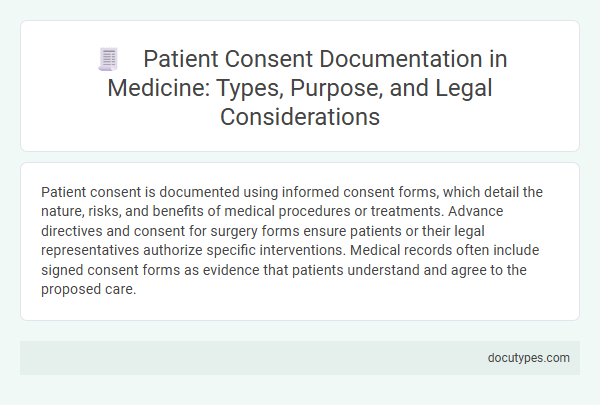Patient consent is documented using informed consent forms, which detail the nature, risks, and benefits of medical procedures or treatments. Advance directives and consent for surgery forms ensure patients or their legal representatives authorize specific interventions. Medical records often include signed consent forms as evidence that patients understand and agree to the proposed care.
Introduction to Patient Consent Documentation
Patient consent documentation is essential in medical practice to ensure that individuals are fully informed before undergoing any treatment or procedure. These documents serve as legal proof that the patient understands the risks, benefits, and alternatives involved.
Common medical documents used to record patient consent include consent forms, advance directives, and surgical consent agreements. These forms are tailored to specific procedures and treatments, outlining detailed information to protect both patient rights and healthcare providers. Accurate and thorough documentation helps prevent legal disputes and ensures compliance with healthcare regulations.
Importance of Consent in Medical Practice
Patient consent documents are essential in medical practice to ensure that You understand and agree to proposed treatments. These records protect both the patient's rights and healthcare providers' legal responsibilities.
- Informed Consent Form - This document details the treatment, risks, benefits, and alternatives to ensure the patient's understanding before proceeding.
- Consent for Surgery - Specific authorization is recorded for surgical procedures to confirm patient agreement and comprehension.
- HIPAA Authorization Form - Used to document patient permission for sharing medical information, protecting privacy rights.
Types of Patient Consent Forms
Medical documents used to record patient consent include various types of consent forms tailored to specific procedures and treatments. Common types of patient consent forms are surgical consent, informed consent for medical treatments, and consent for diagnostic tests or blood transfusions. You must ensure that the appropriate consent form is signed to document your agreement and understanding before any medical intervention.
Informed Consent: Definition and Requirements
| Medical Document | Description | Key Components |
|---|---|---|
| Informed Consent Form | A legal document that records the patient's agreement to undergo a specific medical procedure or treatment after being fully informed. |
|
| Consent for Surgical Procedures | Specialized consent forms tailored for surgeries, ensuring the patient understands the nature and risks of the surgery. |
|
| Consent for Clinical Trials | Documents used to obtain consent from patients participating in medical research studies, emphasizing voluntary participation and confidentiality. |
|
| Consent for Blood Transfusion | Forms that document patient consent for receiving a blood transfusion, with clear explanation of risks and benefits. |
|
Informed consent is defined as the process through which your healthcare provider communicates all essential information about a medical intervention, ensuring you understand the procedure, possible risks, alternatives, and benefits. This process requires clear communication and voluntary agreement, documented by your signature on the appropriate medical consent form.
Implied vs. Explicit Consent
Medical documents used to record patient consent include consent forms, medical history records, and procedure-specific authorization documents. These documents ensure health care providers obtain permission before performing treatments or procedures.
Implied consent occurs when a patient's actions suggest agreement to treatment, such as extending an arm for a blood draw. Explicit consent requires a clear, verbal or written agreement, often documented through signed forms before medical interventions.
Special Considerations: Pediatric and Incapacitated Patients
Medical documents used to record patient consent include consent forms, advance directives, and authorization agreements. For pediatric patients, consent is typically obtained from a parent or legal guardian, with assent sought from the child when appropriate. In cases of incapacitated patients, a legally authorized representative provides consent to ensure that Your medical care aligns with your best interests and legal requirements.
Legal Standards and Regulatory Frameworks
Medical documents used to record patient consent are essential for ensuring compliance with legal standards and regulatory frameworks. These documents protect both the patient's rights and the healthcare provider's responsibilities.
- Informed Consent Form - This document details the treatment or procedure, risks, benefits, and alternatives to ensure that you are fully aware before agreeing.
- Treatment Authorization Form - Used to legally authorize specific medical treatments, aligning with healthcare regulations and institutional policies.
- HIPAA Consent Form - Records patient permission for the use and disclosure of protected health information, complying with federal privacy standards.
These forms maintain legal validity by adhering to jurisdiction-specific regulations and institutional guidelines.
Documentation Best Practices for Healthcare Providers
What medical documents are used to record patient consent? Patient consent is typically documented using informed consent forms that outline the risks, benefits, and alternatives of a procedure or treatment. These forms ensure legal protection and clear communication between healthcare providers and patients.
How can healthcare providers ensure documentation best practices for patient consent? Accurate and timely documentation involves using standardized consent forms tailored to specific treatments and procedures. Documenting verbal consent in the medical record and obtaining signatures prior to treatment safeguards patient rights and supports compliance with legal regulations.
Common Challenges and Solutions in Consent Documentation
Medical documents used to record patient consent include consent forms, advance directives, and operative reports. These documents ensure patients understand the procedures, risks, and benefits before agreeing to treatment.
Common challenges in consent documentation involve incomplete forms, unclear language, and lack of patient comprehension. Solutions include using standardized templates, plain language explanations, and verifying patient understanding through teach-back methods.
What Medical Documents Are Used to Record Patient Consent? Infographic

